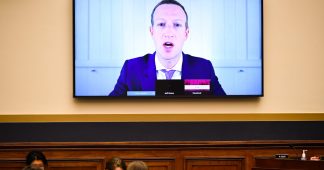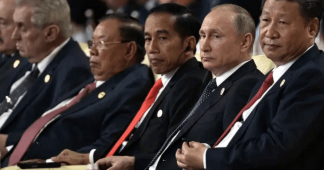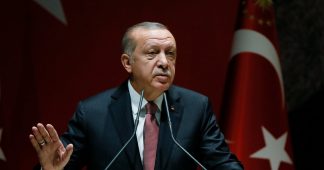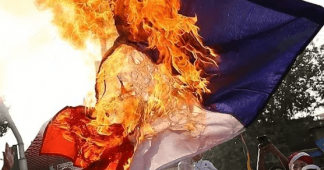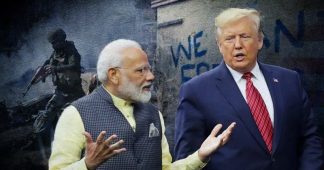By Kamya Yadav, Isra Thange,
Julia Ilhardt, Samikshya Siwakoti, Jacob N. Shapiro
November 25, 2020
photo: Credit: ChocolateLr18. CC BY-SA 4.0.
Since COVID-19 spread to South Asia, there has been no need for government officials, news anchors, or private individuals spreading misinformation about the pandemic to reinvent the wheel. They’ve simply exacerbated the same tensions that have long existed between the major religious groups in the region. In countries like India, which has a sizable Muslim minority population, the false stories circulating about the pandemic have mostly blamed that community for COVID-19’s rapid progression. In majority Muslim countries like Pakistan, popular clerics and others have claimed Muslims are immune to getting sick. The various strains of misinformation are making it harder for health authorities to actually tamp down on the spreading virus.
Under Prime Minister Narendra Modi’s Hindu nationalist government in India, Muslims have been subject to citizenship laws deemed anti-Muslim, brutal lynchings, and violence, including riots that broke out in Delhi earlier this year. The revocation of Article 370 of India’s constitution in August 2019 stripped the country’s only Muslim-majority state, Jammu and Kashmir, of its semi-autonomous status. Once the pandemic began, hatred, suspicion, and misinformation directed at Indian Muslims easily incorporated lies about COVID-19, exacerbating long-standing Islamophobic sentiments in the country.
One important moment involved reports that a Sunni Muslim missionary movement, Tablighi Jamaat, had spread COVID-19 during a large gathering in March. Authorities said the event caused a spike in coronavirus cases. Afterword, online misinformation accusing Muslims of spreading COVID-19 went viral. Social media posts began to circulate showing Muslims licking plates. In fact, the posters had repurposed a pre-pandemic video of a Bohra Muslim ritual about not wasting food and used it to ignite anger at Muslims. Other stories making the rounds accused Muslims of spreading the virus by spitting on food, violating lockdowns, and not observing social distancing protocols.
Anti-Muslim misinformation has spread to Nepal, as well.
In April, when two Muslim women accidentally dropped money on the road, rumors on social media alleged that they were COVID-19 positive and had spit on the bills. Poorly-sourced speculation about the role of Muslims in spreading the virus and accusations of using COVID-19 as a “suicide bomb” became common on social media and traditional media alike.
Nepal, like India, is a Hindu-majority state. Unlike India, however, outright violence against Muslims or blatant Islamophobia is rare, although in December 2016, a group of Hindus attacked Muslims during a religious parade in Narainapur, leading to two deaths.
But violent, anti-Muslim incidents in Nepal are few and far between, making the Islamophobic COVID-19 misinformation particularly troubling.
In contrast, Sri Lanka has a history of anti-Muslim sentiments.
After the Easter Sunday bombings in 2019, for instance, Sinhalese Buddhists turned against innocent Muslim communities on the island. Mosques, Quranic schools, and Muslim-owned shops and houses were attacked as Buddhist hardliners raged against Muslims. Sri Lankan President Gotabaya Rajapaksa, rode Buddhist anger into power, and some see his majoritarian politics as a threat to Muslim minorities in the country.
Sri Lankan social media has been rife with rumors demonizing minority Muslims. In our data, almost 82 percent of Sri Lankan misinformation narratives were spread by individuals on social media.
Government policies, such as mandating cremation of COVID-19 victims, contributed to the perception that Muslims were responsible for spreading the virus in Sri Lanka because they bury the deceased instead of cremating them. (The World Health Organization has stated that victims of COVID-19 can be buried or cremated.)
South Asia’s Muslim-majority states have a different spin on communal COVID-19 misinformation, one in which Islam supposedly offers resistance to getting sick. “Twenty million Chinese converted to Islam after seeing proof that COVID-19 did not affect Muslims,” one Facebook post in February claimed. But other narratives blame outside groups for bringing in the virus, which Muslims supposedly can’t get sick from in the first place. Afghani migrants, from Iran, for instance, were blamed for bringing COVID-19 with them as they crossed back into Afghanistan.
Misinformation on Facebook emphasized that both the cause and cure of coronavirus have been discussed in the Quran for fourteen centuries. In Pakistan, clerics and prayer leaders told worshippers to continue congregating at mosques without fear: Muslims were immune to COVID-19, they said. Hindu funerals were targeted due to rumors that COVID-19 can spread through the cremation fumes.
The sources of misinformation. Approximately 75 percent of the misinformation narratives we identified in South Asia were distributed by individuals on social media, especially WhatsApp. Bangladesh and Nepal were the exception, with the largest share of misinformation in those countries originating from media outlets. For example, in Nepal, several news sources, such as Rajdhani Daily and NepalLive, were found to have reported inflated case numbers. In Bangladesh, the claim that wearing a hijab would help prevent the spread of COVID-19 first appeared on a number of news websites before being amplified on Facebook. Meanwhile, in Nepal, political leaders promoted widely circulating fake COVID-19 remedies and cures. Some people in Afghanistan claimed the government has been reporting artificially inflated numbers of coronavirus cases and incentivizing citizens to report more cases in order to bring in international aid. The government has denied these rumors.
In Sri Lanka, pro-government media organizations exacerbated anti-Muslim sentiments through their reporting of sensationalized misinformation, including referring to Sri Lankan Muslims as “rogue” elements spreading the virus.
South Asian governments have done little to quell misinformation. In fact, politicians and governments and their supporters in several countries have contributed to its spread.
London School of Economics researchers Shakuntala Banaji and Ram Bhat have argued that the “well-oiled machine” run by Modi’s political party in India, the BJP, and its allies utilizes a complex network of friendly news anchors and others to spread disinformation, often targeting Muslims. “The steps in this manufacture and circulation of violent disinformation often involve both mainstream and social media,” they write. This network has rapidly adapted to include COVID-19 into its narratives.
The ability of nonprofits, media organizations, and governments to combat coronavirus-related misinformation varies across the region.
Based on our database, we found that India has several fact-checking organizations, including BOOM, SM Hoax Slayer, and Alt News. Sri Lanka has three–Fact Crescendo, Watchdog Sri Lanka, and Fact Check—and Nepal has two—South Asia Check and Nepal Fact Check. In Pakistan, we found one—Soch Fact Check—while we found none for Afghanistan. Although Pakistani doctors and politicians have contributed to the spread of vaccine-related conspiracy theories and fictions about the efficacy of various herbal treatments, a government-run Twitter account called @FakeNews Buster goes weeks without posting and has not directly addressed COVID-19 misinformation.
There are, however, efforts to confront misinformation, even in Afghanistan, where only 50 percent of the population is literate and where many press releases or social media posts, typical vehicles for public health information, wouldn’t ordinarily reach their target audiences. A government program called Targeting the Ultra Poor has adopted a unique, human-oriented approach, in which health workers and community elders are cooperating to disseminate correct health information in person.
Other government interventions are potentially less helpful.
Pakistan passed new laws to curb the spread of fake stories about the pandemic, but activists worry the efforts could be used by the government to stifle political dissent. People have already been arrested for sharing false coronavirus claims in India and Nepal.
While the curve of COVID-19 cases is different across the countries of South Asia, falling in India and rising in Pakistan, for example, the pandemic is highlighting one common problem throughout the region: Old prejudices, fueled by disinformation, are making it harder to fight a virus now threatening all countries.
(The authors would like to thank Sameer Rana, Mehulika Sitepu, Nicola Bariletto, Shahim Khabuli, Wafa Zaka for their contributions.)
Published at thebulletin.org

